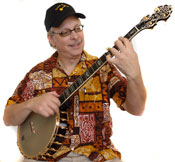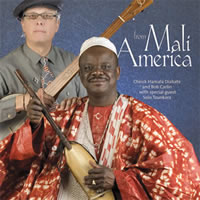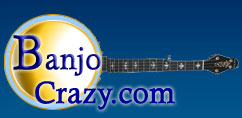Bob Carlin - Banjo Missionary - by Paul Roberts

“My husband plays banjo, too,” said Rachel Smith, to a banjo-toting man attending one of her pottery exhibitions. The man was excited about a breakthrough he had just made after listening to a CD, and suggested to Rachel that her husband might want to check out a great banjo player named Bob Carlin…who, it turns out, is Rachel’s husband.
Ironic, but sage advice. If there are more clawhammer banjo players in the world today than ever before, one of the contributing factors has been the lifework of a great banjo player…by the name of Bob Carlin.
Beginning with his seminal work, “Melodic Clawhammer Banjo,” recorded in 1977, Bob’s career has been centered on traditional Southern banjo music. For over thirty years his performances, recordings, lectures, workshops, research and prodigious writings have greatly enhanced the appreciation and knowledge for the banjo - and supplied road maps for aspiring banjoists seeking the authentic clawhammer style.
Besides producing instructional materials and an abundance of articles, Bob is the author of two books: “The Birth of the Banjo - Joel Walker Sweeney and Early Minstrelsy,” (a look at the banjo in the South — how it went from black to white hands and the minstrel scene), and “String Bands in the North Carolina Piedmont,” (a definitive narrative on rich musical heritage of North Carolina).

Recently, Bob has been exploring the African roots of the banjo, with Cheick Hamala Diabatethe, a Malian musician. In their performances and on their CD, “From Mali to America,” they take the banjo on a journey from West Africa to the American south and back around the world again - playing various historical banjos and West African lutes.
Besides being a proselytizer for the venerable clawhammer style, Bob has helped bring American musical history to life as one of the pioneers in the rediscovery of mid-1800s minstrel-style banjo playing. He has had a long, distinguished career as a soloist, longtime collaborator with John Hartford and numerous other notable musicians.
Interview with Bob Carlin
Would you say something about your own subjective experience of playing the banjo?
Whenever I pick up the banjo, I instantly access all the musical experiences that I’ve had with the instrument– whether it be with the older musicians from whom I learned or the many jam sessions and bands that I’ve been in over the years, my playing with John Hartford, the late-night session I was in at the Smithsonian Festival with Ali Farka Touré, playing African music…all of these things come alive as soon as I pick up the instrument, they just come to the forefront of my memory.
You’ve been described you as a crusader in the preservation and dissemination of information about the banjo. Do you consider yourself a traditionalist?
All of my work, I think, references tradition in one way or another; it’s very important to me. With stringed instruments that grew out of a certain tradition, I think it really helps your playing to have knowledge of that tradition. I feel like if you’re going to depart from tradition, it’s always better to know the tradition before you reject it; if you reject it first and try to make something up, it won’t have nearly the resonance of something that references the tradition.
What’s the scope of your current performances?
Most of my performing, these days, is with my West African friend, Cheick Hamala Diabatethe, from Mali. We do this crossover thing that tries to musically show - in a performance situation - the relationship between the West African and American music, using lutes from West Africa and American banjo.
How did this collaboration come about?
It’s developed organically over time. I started informally working with Cheick Hamala in 1995 when he first came to America. He spoke no English then. After a certain amount of time playing together, it grew into ‘why don’t we get some concerts and we’ll do a few tunes together?’ That turned into a performance in which we both played the whole evening together. And then it was ‘why don’t we try doing a record?’ Our CD, ‘From Mali to America,’ is our attempt at combining American and African banjo music.
It’s a fascinating cultural crossroads. What instruments are you using?
I play my Gold Tone BC-350 [Bob Carlin signature model]. He’s left-handed, so he has a left-handed version of the BC-350. We also both use 19th century replica gourd banjos made by Pete Ross, and I play a minstrel banjo made by George Wunderlich. Cheick Hamala also plays guitar and various West African lutes, called ngoni.
What other kinds of shows are you doing?
I’ve been doing some history of the banjo shows, and smaller-scale performances in conjunction with my teaching at banjo weekends where I try to represent the styles of the traditional players from whom I’ve learned, like Tommy Jarrell and Fred Cockerham. Until recently, I performed with Joe Thompson, one of the last, if not the last, African American fiddler. I also do lecture demonstrations for state libraries, historical societies and other institutions, as well as book signings and other book events.
What were some of the early experiences that contributed to your music career?
My mother took me to see Pete Seeger when I was five and that must have planted a seed.
There was a big emphasis on being cultural and appreciating music and art in my family. We lived outside of New York City so we would go to Leonard Bernstein’s Young People’s Concerts and to the museum of natural history. I had the normal run of childhood piano lessons and I played trombone in the school band. I became interested in folk music because my parents had Leadbelly, Woody Guthrie and Pete Seeger records around the house. They were involved in social causes where they’d see these people play. They’d also go folk dancing and to music weekends where they’d have people like Reverend Gary Davis playing.
From an early age, I attended Buck’s Rock summer arts camp where the sound track was guitars, banjos and folk music. Everybody was strumming guitars and singing Puff the Magic Dragon. The camp hosted a number of performances, including ones by Pete Seeger and Simon & Garfunkel.I started playing guitar when I was 12, and the banjo when I was 15. One of my early banjo teachers was a counselor at that camp, Jerry Marks, who was very influenced by both Mike and Pete Seeger. Jerry was the one who taught me to drop my thumb on the inside string. At the same camp, I met Roy Bookbinder who got me playing country blues guitar. Roy brought Reverend Davis up to the camp several times to play. These were important experiences. I soon picked up other instruments - mandolin and dulcimer - kind of following the model of people like Mike Seeger, learning as many stringed instruments as I could.
Did you start performing early on?
Oh yeah, I started performing right from the get-go; couldn’t keep me off the stage. I was president of the folk music club in my high school - we put on yearly concerts. I played in coffee houses around where I lived. I was trying to get out and perform almost from the beginning.
What did you study in college?
I studied music to begin with; took a year off to perform as a professional musician, then went back and got a degree in journalism, radio and communications. I ran the coffee house at college and played there all the time.
You mentioned Jerry Marks. Who were some of your other influences?
I played with Hank Sapoznik who was playing a sort of nascent melodic style (we taught together at Buck’s Rock summer camp), and some other people around New York. What really pushed me forward was when I went to North Carolina and Virginia for the first time in 1975 - that’s what really got me interested. I went down a guitar player and came back a banjo player because I got so excited about the music. After seeing both young and old musicians living in the South playing the old-time music, it really got me going. It changed my whole attitude about the music.
And you later moved there?
Yes, I moved to Lexington, North Carolina in 1989 because I wanted to understand the culture better of the music that I played, and also to be around the purveyors of the tradition while they were still living - so many of them had died before I had moved down there. I kind of caught the very end of it. Those were the reasons: to be around the culture and the musicians, the music. So many of the real old-time players were getting on in years and I felt a needed to get things down before it was too late.
What’s the present interest level in clawhammer banjo?
Openback banjo sales are way up and the interest in instructional material has been way up. The banjo camps are bigger every year - I keep seeing new faces.
My wife jokes that one day I’ll become the old guy, and they’ll all be camping in our backyard. But it hasn’t happened yet. I still have to go to them (laughs).
![]()
 Paul Roberts is a multi-instrumentalist, performer, composer, writer, music therapist
Paul Roberts is a multi-instrumentalist, performer, composer, writer, music therapist
and arts-in-education specialist, whose articles and interviews are featured on BanjoCrazy.com and the BanjoCrazy.com Blog at wordpress.com
all articles ©2008 by Paul Roberts all rights reserved
More Articles |
Bob's Recordings |
Instructional Videos |
| Bob Carlin - Banjo Missionary | ||
| Bob Carlin - Cello Banjo History | ||
| Bob Carlin Talks About Cello Banjos |
 Bob Carlin , Clawhammer Banjo, African Banjo, Traditional Music
Bob Carlin , Clawhammer Banjo, African Banjo, Traditional Music From Lexington, North Carolina
Visit Bob's website Bob Carlin Music at http://www.bobcarlinmusic.com/
